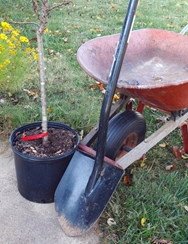The Correct Planting Depth
Tree Planting Guide
Deep is good, right? Not when planting a tree. This tree planting guide will show you the importance of planting a tree at the right depth.
Trees don’t come with an instruction manual, but they probably should. True, it's not rocket science, nevertheless, there are important things to know. Whether its planting bare root trees or balled and burlaped trees, one thing is consistent, most people do not know the correct planting depth for a tree.
Number One Mistake
Probably the number one mistake we make is in planting the tree too deeply. Even nurseries are guilty of doing this. The problem is more serious than it appears. It all boils down to the roots and how deeply they are planted. This tree planting guide will answer that.
When you purchase a tree grown in a container, the roots are already growing at the proper soil depth for the conditions. If you plant the tree at a deeper depth it will affect how the roots will grow from that point.
Even an inch too deep on small bareroot stock trees is significant. The effects of planting too deeply often do not show up right away, but can appear several years later.
Planting at the Correct Depth
When planting a tree, place the tree in the ground. The top of the soil in the planter becomes the highest point. Do not plant it deeper so you are pouring soil on top of the planter's soil.
If you have to stake the tree to make it more steady, that's fine. The roots will grow into the soil and begin to hold it tightly.
Examples of Root Flares
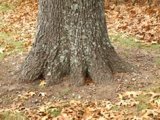
| 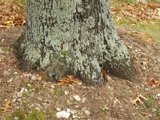 |
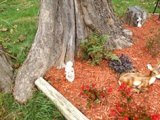 |
Take a look at these tree planting guide photos above. The first two are oaks and the third is a Catalpa Tree.
The trees above are not nursery trees, but are native trees growing on a small farm. Notice the gentle curve of the root flare at the bottom of the tree?
The Importance of Seeing a Root Flare
Root flares are more easily seen in large trees like these, but all trees have root flares because all trees have roots. The top of the root flare should always be above ground. This root flare’s natural curve represents the place where the roots branch off from the truck.
The majority of roots will be found in the top 10 inches of soil in large trees, so the curve sends the roots off in the right direction.
The Tree Planting Guide for Finding the Root Flare
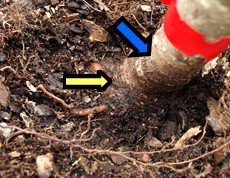
The dwarf peach tree in the photo is growing in the nursery container. It was started as a bareroot plant. How do I know? It was planted about a couple inches too deep. I brushed away the soil in order to find the root flare.
Notice the blue arrow. It shows where the soil line was and that it was above the root flare. For a new container plant you are planting, an inch is a lot of distance.
The root flare is marked with a yellow arrow. I know an inch doesn’t seem like much, but the rootstock was probably only 18 inches tall and less than ½ inches wide when planted. In that situation, an inch is deep for such a small tree.
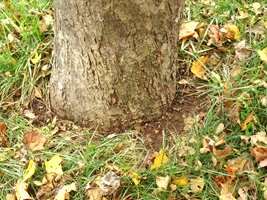
Trees Can Die Sooner Than Expected
The apple tree trunk to the left shows no root flare. The tree is approximately 15 years old. It was planted too deeply and very possibly has a root girdling problem below ground. One side of the tree is now dying and may need to be removed this winter. It will take some digging to confirm if a root problem was the cause of the dieback. This apple tree is now more susceptible to apple tree diseases or insect problems. Whenever you do not see any root flare you can suspect the possibility of girdling roots.
What happens when a tree is planted too deeply?
The roots of a tree naturally adjust to a certain soil depth. Roots will grow at a particular depth where they are able to receive water, minerals, and oxygen. It is not uncommon to see the tree's root ball covered with a foot of soil. That is a foot too deep. The roots of deeply planted trees will search for water and oxygen often growing straight upward where conditions are better.
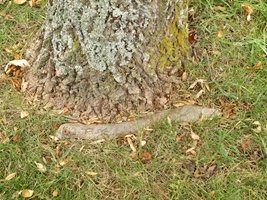
Container Bound Circling Roots
Roots in containers have nowhere to go. The hit the container wall and start growing in circles. This is normal, but it must be corrected.
Roots should be growing out from the tree in circles. Before planting the tree, take a knife and cut vertically along the outside from top to bottom about 1/2 to 1 inch deep. Do this at least twice on each side of the root ball. This will cut the outside roots and when the start to regrow they will grow out.
If you don't cut them they will continue to grow in a circle. As the truck get bigger, the circling roots will strangle the tree.
Notice the girdling root in the photo. As the tulip popular continues to grow in diameter it will press harder against the root, possibly cutting off nutrients to that section of the tree. Girdling roots can slowly strangle a tree over time.
What to do with girdling roots in established trees
The best way to correct a girdling root problem is to cut the root. Roots do not move in the soil so it will need to be cut to keep it from harming the tree later.
If the root is large and you are unsure how it will affect the tree, be sure to contact an arborist. In some areas, like where I live, a representative from the Dept. of Conservation will give you free advice. The conservation agent may not be a certified arborist, so be sure to ask if he as experience in that area.
(All photos used on this tree planting guide page were taken by Russell James)
Pictorial Guide to Pruning Trees
Pruning trees just got easier. Click on our pictorial guide that shows how to correct structure problems, how to prune young shade trees, fruit trees, and some small upright trees.
Complete Tree Planting Instructions
There is a lot more to planting a tree correctly than most people realize. This page covers everything you need to know from choosing the planting location to amending the backfill soil.
Tree Planting Guide back to Total Tree Care
Introduction page to Lawn Care Academy's Tree Care pages.
Tree Planting Guide back to Lawn Care Academy Home
